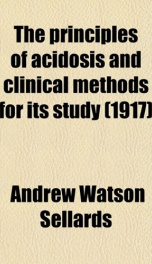the principles of acidosis and clinical methods for its study

Purchase of this book includes free trial access to www.million-books.com where you can read more than a million books for free. This is an OCR edition with typos. Excerpt from book: Ill METHODS OF DIAGNOSING ACIDOSIS Clinical Signs. The state of acidosis is accompanied by certain clinical manifestations one of which is very characteristic. In advanced cases, the respiration becomes moderately rapid; the striking feature in uncomplicated cases is not the increase in rate but the pronounced increase in depth with a somewhat prolonged expiration. This dyspnoea is accompanied not by cyanosis but by a bright color, even at times an abnormally bright color, of the mucous membranes. Physical examination of the chest shows nothing to account for this labored respiration. Such a picture constitutes a typical air hunger and is a very characteristic symptom provided that no complicating factors are present. It occurs, however, only in advanced stages of acidosis. Laboratory Methods. For the detection of the earlier stages a fruity odor of the breath is of course very helpful in diagnosing diabetic acidosis, but it is preferable to consider here only the general methods applicable to all types. A variety of laboratory methods are available. These may be conveniently listed as follows: I. Examination of the blood for 1. lowering of alkalinity, 2. lowering of carbon dioxide content. II. Examination of respiration for lowering of carbon dioxide tension in alveolar air. III. Examination of urine for 1. excess of acid, or for abnormal acids, 2. change in fixed bases, 3. increase in ammonia output. Of this list it is obviously desirable to select some clinical method which shall be firstly, sufficientlj- delicate to detect the early grades, and secondly, shall be applicable to all types regardless of etiology, and in the third place shall be pathognomonic of acidosis. In the examination of the blood, titration methods for changes in alkal...
Info about the book
Author:
Series:
Unknown
ISBN:
1449674321
Rating:
4/5 (3)Your rating:
0/5
Languge:
English
Users who have this book
Users who want this book
What readers are saying
What do you think? Write your own comment on this book!
write a commentif you like the principles of acidosis and clinical methods for its study try:
Other books by this author
Do you want to read a book that interests you? It’s EASY!
Create an account and send a request for reading to other users on the Webpage of the book!


